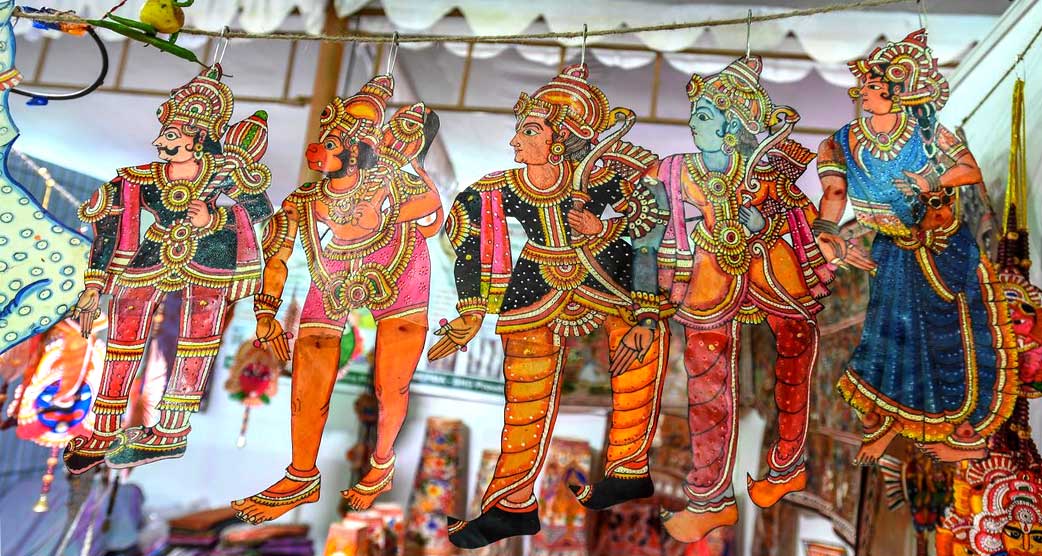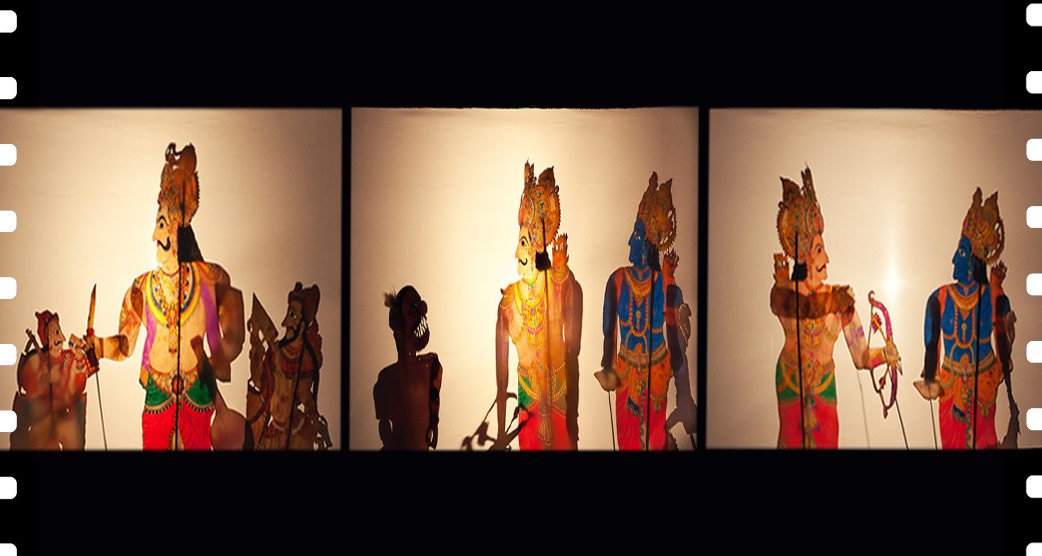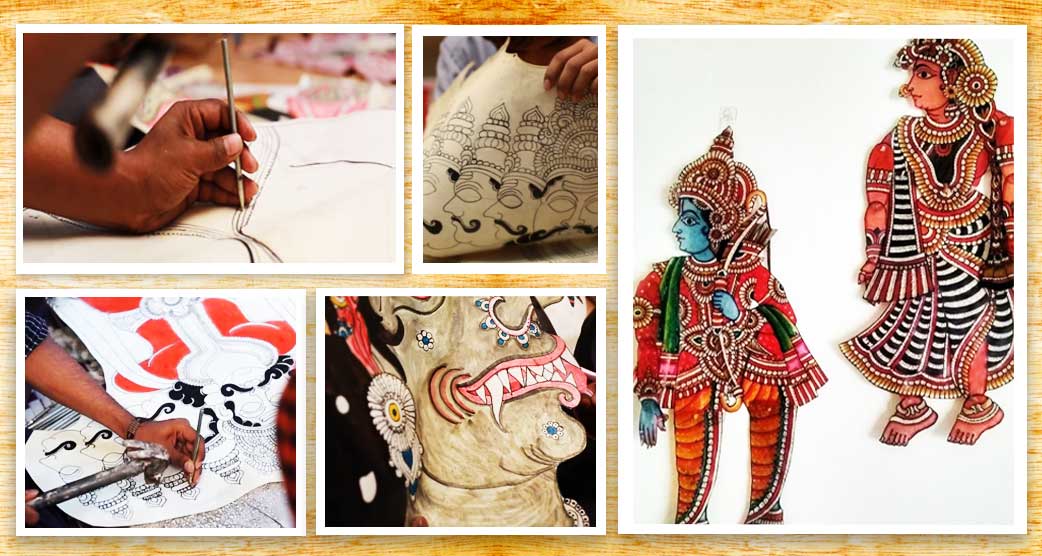
One of the earliest shadow puppet traditions in India is Andhra Pradesh’s leather puppetry. It serves as a platform for entertainment, the dissemination of folklore, and the exchange of knowledge and information. The societal environment surrounding the artists has impacted most leather puppets and continues to do so.
Shadow puppetry’s origins were closely tied to religious doctrine and traditional cultural practices, just like most other performing arts in India. It mostly portrayed stories from religious books, such as the Mahabharata and the Ramayana, fusing them with regional traditions and legends.
The Anantapur district’s Nimmalakunta is where this very compelling art style was first created. Tholu bommalata is preceded by the sweet emotion that wherever the location is selected to be the stage for the puppet show would have plenty of rain and wealth. In Telugu “Tholu” means “leather” and “bommalu” means “dolls”.
The background conversation and music of “Tholu bommalata,” which is well-known for portraying some historical events. It is typically performed by the artists and accompanied by drums and harmonium.
And to put on the performance, these performers travel from remote areas. And what appears to be only the movements of faces as a kind of art has been blocked off for one hour each day by hours of labor from artisans working around the clock.
Shadow puppetry’s origins were closely tied to religious doctrine and traditional cultural practices, just like most other performing arts in India. It mostly portrayed stories from religious books, such as the Mahabharata and the Ramayana, fusing them with regional traditions and legends.
The Anantapur district’s Nimmalakunta is where this very compelling art style was first created. Tholu bommalata is preceded by the sweet emotion that wherever the location is selected to be the stage for the puppet show would have plenty of rain and wealth. In Telugu “Tholu” means “leather” and “bommalu” means “dolls”.
The background conversation and music of “Tholu bommalata,” which is well-known for portraying some historical events. It is typically performed by the artists and accompanied by drums and harmonium.
And to put on the performance, these performers travel from remote areas. And what appears to be only the movements of faces as a kind of art has been blocked off for one hour each day by hours of labor from artisans working around the clock.
Let’s Know The Origin Story Of This Beautiful Art

A work done with absolute love and pure devotion becomes an art, and the people of Nimmalakunta a small village in Andhra Pradesh (India), practice one such art, leather puppetry. Any area has an identity through its people, and people identify themselves through their culture. From a distance, anyone might see this as a little, tranquil village where residents are busy doing their daily activities. But as we go further, we discover that this village is home to a more than 500-year-old art tradition known as leather puppetry.
The people of Nimmalakunta sat with their reknit and began recreating the Divine with each stroke of black ink every day after offering a daily prayer to the supreme Being. This village’s houses are all re-creating this treasure, which can be seen in things like lamps and puppetry. But the method for punching holes in the leather is one thing that unites them all. Historically, puppetry was utilized to narrate the stories of the sacred Ramayana and Mahabharata. But throughout time, this craft has been incorporated into consumer goods, becoming the main source of income for artists.
The people of Nimmalakunta sat with their reknit and began recreating the Divine with each stroke of black ink every day after offering a daily prayer to the supreme Being. This village’s houses are all re-creating this treasure, which can be seen in things like lamps and puppetry. But the method for punching holes in the leather is one thing that unites them all. Historically, puppetry was utilized to narrate the stories of the sacred Ramayana and Mahabharata. But throughout time, this craft has been incorporated into consumer goods, becoming the main source of income for artists.
How This Art Of Entertainment And Devotion Is Created?
Everyone could enjoy the puppet shows, which featured both religious epics for the pious and comedic relief for the unfocused. Despite the fact that there are fewer puppeteers today, puppetry is still performed, especially at festivals.
Tholu Bommalata (Tholu = leather; Bommalata = puppet dance) is the name of Andhra Pradesh’s leather shadow puppetry. The Sutram Bommalata (string puppets) and the Koyya Bommalata (wooden puppets) are two more forms of shadow puppetry that are performed in Andhra Pradesh.
The most well-liked puppets are made of leather because of their transparency and jewel-like brilliance. Near Kakinada, in Madhavapatnam The primary centers for leather puppets are in the districts of Palli in Nellore, NimmalaKunta in Anantapur, and Narasaraopet in Guntur.
Tholu Bommalata (Tholu = leather; Bommalata = puppet dance) is the name of Andhra Pradesh’s leather shadow puppetry. The Sutram Bommalata (string puppets) and the Koyya Bommalata (wooden puppets) are two more forms of shadow puppetry that are performed in Andhra Pradesh.
The most well-liked puppets are made of leather because of their transparency and jewel-like brilliance. Near Kakinada, in Madhavapatnam The primary centers for leather puppets are in the districts of Palli in Nellore, NimmalaKunta in Anantapur, and Narasaraopet in Guntur.
Process Of Making Leather Puppets
Getting The Leather Sheet Ready
The artisans utilized goatskin to create the leather sheet. They get it from a local butcher shop. It is softened by soaking it in water for a few hours after being sourced. The hair on the skin is then removed after it has been fully flattened and thoroughly cleansed in hot water to destroy all bacteria.
The skin is then washed and cleaned numerous times until it becomes transparent paper. After drying for a few days, this process is repeated. Despite the complexity of the original process, some artists are now seen importing paper from other countries to circumvent the tiresome cleaning procedure.
The skin is then washed and cleaned numerous times until it becomes transparent paper. After drying for a few days, this process is repeated. Despite the complexity of the original process, some artists are now seen importing paper from other countries to circumvent the tiresome cleaning procedure.
Rough Sketches Of The Puppets
Then, using a pencil, the characters’ outlines are drawn on leather paper. The artists create incredibly detailed drawings of the deities they intended to use as puppets. The drawing is extremely meticulous, down to the last detail.

Adding Color To The Puppets
Following that, a bamboo nib is used to paint the deity drawings (and not a brush). After the figures are generated, the outline is drawn, and the marked spaces are filled with rich colors (generally the brighter ones).
Previously, these colors were created using natural pigments; however, today’s artists choose acrylic paints and brushes.
Previously, these colors were created using natural pigments; however, today’s artists choose acrylic paints and brushes.
The Cutting And Sewing Of Puppets
After painting the components, the figures are cut out, and the assembled puppet is created by sewing the cut-out pieces together. It’s noteworthy to note that this technique gives the puppet more flexibility because it allows for fluid and elegant movements. The craftspeople also use a special type of stitching that entails fastening the puppet with ropes or attaching it to a rod or handle to increase its mobility.
Setting Up The Puppets
The products are cut into individual pieces, which are then sewn together to create the puppets. As a result, puppeteers may move around more easily when performing a puppet show. A stick that will be used to control the puppets is prepared by the artist. The head and limbs of the puppet are cut apart, and they are then attached to each other separately to allow for freedom of movement.




